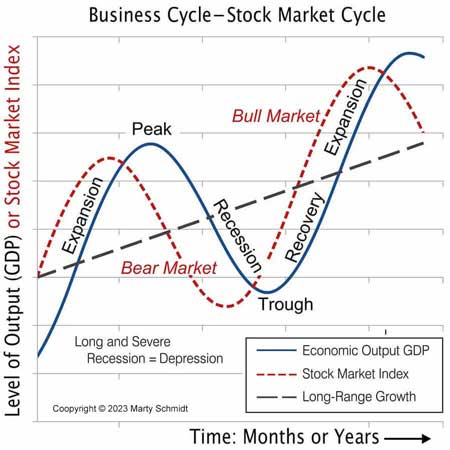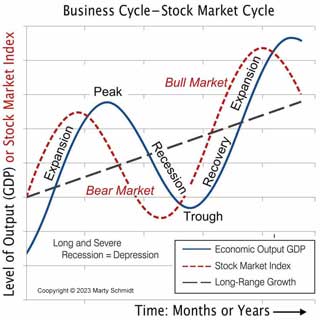What is the Business Cycle?
The Business Economic Cycle is characterized by several well-known phases: Recession, Depression, Recovery, Expansion.
The term business cycle has several different meanings in business. This article presents three of the most frequently used definitions for the term. The primary "meaning" is explained in depth, in context with related concepts such as economic cycle, recession, and depression.
Define Your Terms! What are the Meanings of Business Cycle?
Define Economic Business Cycle
The primary meaning of business cycle refers to fluctuations in economic output in a country or countries. These are the well-known phases of the business cycle such as recession, recovery, and expansion.
Economic cycle is another name for the same sequences:
The economic business cycle often parallels changes in stock market prices, which are part of the stock market cycle. For more on these cycles and their phases, see the sections below.


Define Company Lifespan Business Cycle
Secondly, the term business cycle refers to stages in the lifespan of a single company. Business cycle, " stages" in one company's lifespan may include the following:
- Birth (or Startup) stage
- Initial Growth stage
- Expansion stage
- Maturity stage
- Decline stage
- Demise stage
- (Sometimes) Change into a different company, e.g., through merger or acquisition
The economic business cycle (first meaning above) can impact stages of the company business cycle (second meaning).Birth and Growth stages tend to accelerate during economic recovery and expansion, of course. Company Decline and Demise occur faster during economic recession and depression.
Do companies have a finite lifespan? It makes practical sense for accountants to view companies as ongoing entities that will continue in business indefinitely. In reality, however, most business startups move through all six stages and cease business within a few years.
Regarding US S&P 500 Index companies, research by Richard Foster seems to show a recent rapid decline in average company lifespan. The average lifespan fell from 61 years in 1958 to just 18 years in 2015.1 Depending on how one defines lifespan, however, that decline may not be as severe as it seems. Foster also finds that many companies now avoid Demise by instead Changing into a different company. These changes usually come through mergers and acquisitions. Arguably, such events do not have to end company life. Mostly the same companies continue living as different legal entities, under different names.
Define Ongoing Business Cycle
The third meaning of business cycle also refers to a repeating series of phases in the life of an ongoing business. Here, the sequence does not picture the birth, growth, and demise of a company. Instead, the third meaning describes a repeating series of adjustments a company makes to its business model and strategies.
The series may cover a year or several years, and then repeat many times during the company's life
Note especially that a business cycle in this sense might include stages such as these:
- Firstly, the company takes in revenues from ordinary operations for a year or more.
- Secondly, leaders and analysts re-evaluate company business performance and growth prospects. For this, they give particular attention to evaluating:
- Company business model performance. Here, they will focus mainly on their pricing and margin models.
- Competitive strategy effectiveness.
- Marketing strategy effectiveness.
- Thirdly, leaders adjust or change the business model and strategies.
- Successful strategies and models undergo fine-tuning.
- The company replaces failing strategies and models.
- Finally, the company resumes business for another period before re-evaluating.
Explaining Business Cycle in Context
Sections below further define and describe the primary meaning of business cycle, emphasizing three themes:
- Four Economic Business Cycle phases and their relationship to stages in the Stock Market Cycle.
- Special focus on the nature and differences between Recession and Depression stages of the Business Cycle
- Known causes and "cures" for the Economic Business Cycle.
Contents
Defining Business Cycle Phases
Recession, Depression, Recovery, Expansion
The primary meaning of business cycle and economic cycle refers to changes in economic activity within a country or countries. Because these two terms are names for the same sequence, they are interchangeable. Economists define the cycle by referring to economic output, which they measure as the country's gross domestic product (GDP). Note that GDP is just the market value of all goods and services produced within the country during a year. And, when multi-national companies produce in other countries, that activity is not part of home country GDP.
Exhibit 1 below shows how the rising and falling GDP produces business cycle phases. The model also presents another cycle, the stock market cycle. This cycle typically runs more or less parallel to the business cycle, but ahead of the business cycle. Some analysts, therefore, see the stock market cycle as a leading indicator of future business cycle phases.


The GDP of most countries tends to grow over time, as the long-range growth line in the figure suggests. The long-term growth line serves as a baseline reference. Economic output fluctuates around the baseline with different business cycle phases. Note that stock market prices usually rise or fall ahead of like changes in the economy (GDP).
In reality, these cycles tend to be less predictable, less regular, and less smooth than those in the chart. The length, severity, and sequence of phases may differ from what the figure shows.
Seasonal Cycles Are Different From Economic Cycles
Changes due to seasonality tend to impact some companies and industries more than others. And, they are tied predictably to calendar seasons or short-lived fads. By contrast, the business (economic) cycle has broad impacts across companies, industries, and calendar seasons instead.
Business Cycle Impacts
GDP figures are the primary evidence for the business cycle. It is not surprising, therefore, that people who contribute directly to the GDP feel life-cycle phase changes most keenly. They are most aware of changes in areas such as these:
- Employment and unemployment. Also, in hiring rates.
- Wholesale sales and retail sales. And, especially, consumer sales.
- New building loans and new building starts. Also in mortgage rates.
- Building closures and property foreclosures.
- Business start-ups and business growth. Also, business failures.
Recession vs. Depression
What's the Difference?
What is a Recession?
In the United States, economists define a recession as two consecutive quarters of decline in the GDP. The National Bureau of Economic Research (NBER) provides this definition, but it is not, however, the only definition in use. An alternate interpretation even appears within the NBER, from its Business Cycle Dating Committee. This committee reviews several economic indicators, including employment, real income, retail sales, and other factors. As a result, It defines a recession as the time span between the peak and a trough in the above chart.
The term recession did not appear until the time of the Great Depression of 1929-33. Before that, the term depression could refer to any decrease in economic output. "Recession" was coined at this time to distinguish between the severe conditions of the early 1930s, on the one hand, and less severe economic downturns, on the other hand, such as those occurring in 1910 and 1913.
What is a Depression?
The term depression usually means an economic downturn that is longer lasting and more severe than the more frequently occurring recessions. Sometimes, to define the term more formally, a depression is said to begin when GDP declines more than 10% from the most recent economic peak. By this criterion, the last two real depressions in the United States occurred in these periods:
- From 1929 to 1933—the Great Depression—when the US GDP nearly 33% and unemployment rose to 25%.
- In 1937-38, where GDP declined by more than 18%, and unemployment reached 19%.
By contrast, US GDP declined at most 5% in the severe recession of 1973-75.
In general, periods of economic depression are manifest substantially reduced GDP, as well as severely high rates of unemployment, foreclosures, business closures, as well as significantly reduced wholesale and retail sales activity.
The Economic Business Cycle
Are There Known Causes and Cures?
During recessions and depressions governments and private industry alike are keenly motivated to act on measures that might move the economy back into recovery and expansion. Any attempt to remedy economic downturn, however, should start with an understanding of why slowdowns occur in the first place. And, it would be helpful to know which factors trigger recovery.
This subject is central to the field of macroeconomics. Not surprisingly, this field is characterized by competing theories and speculation, but few established "laws."
A few factors are known to correlate with upturns or downturns in the economy. However, the extent to which they are either causes or results is less well known. These factors include the following:
- An imbalance or balance between country money supply, inflation, and interest rates. In the United States, the Federal Reserve Board (FRB) is responsible for keeping this balance.
- Excessive government spending.
Deficit spending is especially detrimental when spent outside the country or on non-productive domestic programs. - Consumer and business optimism or pessimism.
Here, spending depends heavily on consumer expectations for business growth and inflation. - Substantial increases or decreases in the price of oil.
- Weak demand for goods and services.
The latter factor, weak demand, is a central focus in so-called Keynesian economics (after John Maynard Keynes). Since the 1930s, governments with capitalist economies have held—to some degree—a Keynesian view. This view holds that during recessions and depressions, the government should increase aggregate demand by doing the following:
- Firstly, increasing the money supply.
- Secondly, increasing government spending and reducing taxes.
______________________
1. Foster, R.N. Creative Destruction Whips Through Corporate America. Innosight Executive Briefing, Lexington, Massachusetts, 2015.

